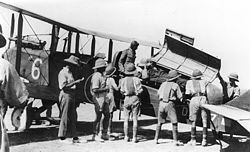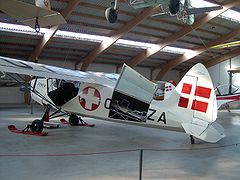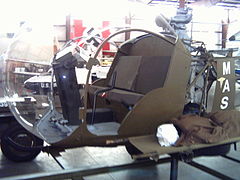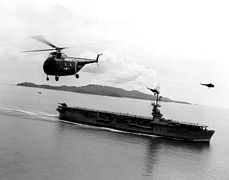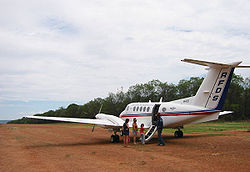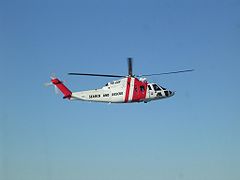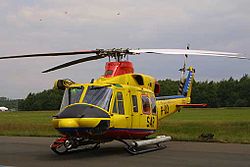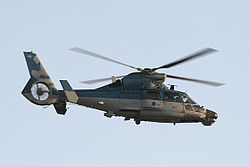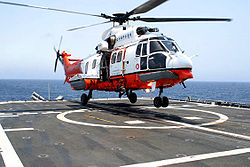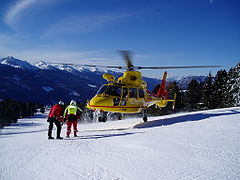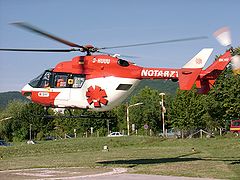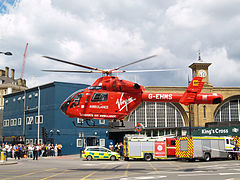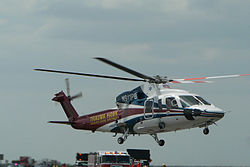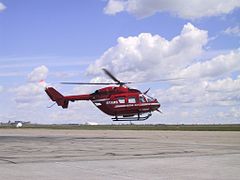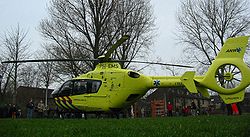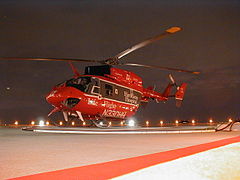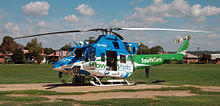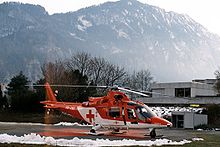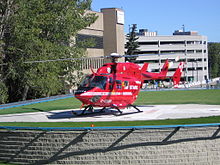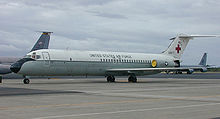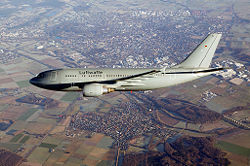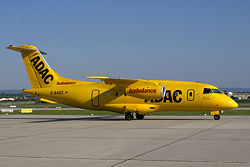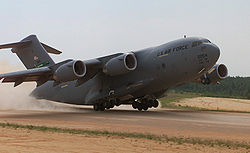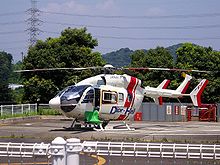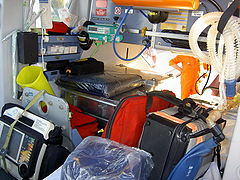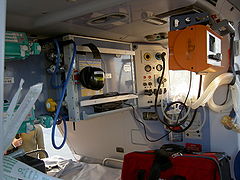- Air ambulance
-
Air ambulance 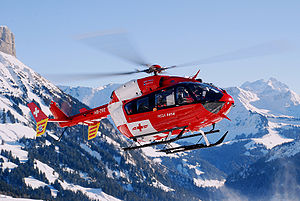
A Eurocopter EC 145 of Switzerland's Rega air rescue service. An air ambulance is an aircraft used for emergency medical assistance in situations where either a traditional ambulance cannot reach the scene easily or quickly enough, or the patient needs to be transported over a distance or terrain that makes air transportation the most practical transport. These and related operations are referred to as Aeromedical. Air ambulance crews are supplied with equipment that enables them to provide medical treatment to a critically injured or ill patient. Common equipment for air ambulances includes ventilators, medication, an ECG and monitoring unit, CPR equipment, and stretchers. An important distinction should be made between a medically staffed and equipped air ambulance which can provide medical care in flight, and the use of a non-medicalized aircraft simply for patient transportation, without care in flight. The military and NATO refer to the former as "Medical Evacuation (MEDEVAC)" and to the latter as "Casualty Evacuation (CASEVAC)" respectively.
Contents
History
Military
As with many innovations in Emergency Medical Service (EMS), the concept of transporting the injured by aircraft has its origins in the military, and the concept of using aircraft as ambulances is almost as old as powered flight itself. It is often stated that air medical transport likely first occurred in 1870 during the Siege of Paris when 160 wounded French soldiers were transported by hot-air balloon to France, but this canard has been definitively disproven.[1] During the First World War air ambulances were tested by various military organizations, and were used regularly for crash rescue by the American Army and Navy within the United States, though none were actually used in combat. Aircraft were still primitive at the time, with limited capabilities, and the effort received mixed reviews. In post-World War I, several Dehavilland DH-4 were converted to air ambulances for the US Army and Navy.[2]
The exploration of the idea continued, however, and fully organized air ambulance services were used by France and the United Kingdom during the African and Middle Eastern Colonial Wars of the 1920s; over 7,000 casualties were evacuated by the French during this period.[3] In 1920 during their suppression of the "Mad Mullah" in Somalialand used a Airco DH.9A fitted out as an air ambulance. It could carry a single stretcher under a fairing behind the pilot.[4]By 1936, an organized military air ambulance service was evacuating wounded from the Spanish Civil War for medical treatment in Nazi Germany. The first use of helicopters to evacuate combat casualties was by the United States Army in Burma during WW2, and the first dedicated use of helicopters by U.S. forces occurred during the Korean War, during the period from 1950–1953. The French notably used light helicopters during their Indochina war of the post-war era.
While popularly depicted as simply removing casualties from the battlefield (which they did), helicopters in the Korean War also expanded their services to moving critical patients to more advanced hospital ships once initial emergency treatment in field hospitals had occurred. Knowledge and expertise of use of aircraft as ambulances continued to evolve along with the aircraft themselves, and by 1969, in Vietnam, the use of specially trained medical corpsmen and helicopters as ambulances led U.S. researchers to conclude that servicemen wounded in battle had better rates of survival than motorists injured on California freeways. This conclusion inspired the first experiments with the use of civilian paramedics in the world.[5] The US military has recently employed UH-60 Black Hawk helicopters to provide air ambulance service during the Iraq War to both civilians and military personnel.[6] The use of military aircraft as battlefield ambulances continues to grow and develop today in a variety of countries, as does the use of fixed-wing aircraft for long-distance travel, including repatriation of the wounded. The next step in this development may be shown by a current NATO working group which is investigating the possible future use of Unpiloted Aerial Vehicles (UAVs) for casualty evacuation.
- Early air ambulance efforts
-
Light helicopters like this Bell 47 Sioux removed the wounded from the battlefield (Korea)
Civilian
The first civilian uses of aircraft as ambulances were probably incidental. In northern Canada, Australia, and in the Scandinavian countries, remote, sparsely populated settlements were often inaccessible by road for months at a time, or even year round. In some cases in Scandinavia, particularly in Norway, the primary means of transportation between communities was by boat. Early on in aviation history, many of these communities began to receive service from civilian "bush" pilots, flying small aircraft and transporting supplies, mail, and visiting doctors or nurses to the isolated communities. Bush pilots probably performed the first civilian air ambulance trips, albeit on an ad hoc basis, but clearly, a need for such services existed.In the early 1920s, Sweden established a standing air ambulance system, as did Siam (Thailand). In 1928 the first formal, full time air ambulance service was established in the Australian outback. This organization became the Royal Flying Doctor Service[7] and continues operating to the present. In 1934, the first civil air ambulance service in Africa was established in Morocco by Marie Marvingt.[8] In 1936 Air ambulance services were established as part of the Highlands and Islands Medical Service to serve the more remote areas of Highland Scotland.
- Australia's Royal Flying Doctor Service
Air ambulances were useful in remote areas, but their usefulness in the developed world was still uncertain. Following the end of the World War II, the first civilian air ambulance in North America was established by the Saskatchewan government in Regina, Saskatchewan, Canada, which had both remote communities and great distances to consider in the provision of health care to its citizens.[9] The Saskatchewan Air Ambulance service continues to be active as of 2011.
In the USA, the country's first air ambulance service, the Schaefer Air Service, was founded by J. Walter Schaefer in 1947 in Los Angeles, California, and operated by Schaefer Ambulance Service.[10] Schaefer Air Service was also the first FAA-certified air ambulance service in the United States. At the time of the creation of the Schaefer and Saskatchewan services, paramedicine was still decades away, and unless the patient was accompanied by a physician or nurse, they operated primarily as medical transportation services. A great deal of the early use of aircraft as ambulances in civilian life, particularly helicopters, involved the improvised use of aircraft belonging to branches of the military. Eventually this would become more organized. This mode of usage occurred not only in the United States, but also in other countries, and persists to this day. Today, there are approximately a half million rotor-wing (helicopter) and fixed-wing (airplane) transports each year in the U.S.[11]
- Military aircraft supporting civilian air ambulance
Two programs were implemented in the U.S. to assess the impact of medical helicopters on mortality and morbidity in the civilian arena. Project CARESOM was established in Mississippi in 1969. Three helicopters were purchased through a federal grant and located strategically in the north, central, and southern areas of the state.[12] Upon termination of the grant, the program was considered a success and each of the three communities was given the opportunity to continue the helicopter operation. Only the one located in Hattiesburg, Mississippi did so, and it was therefore established as the first civilian air medical program in the United States. The second program, the Military Assistance to Safety and Traffic (MAST) system, was established in Fort Sam Houston in San Antonio in 1969. This was an experiment by the Department of Transportation to study the feasibility of using military helicopters to augment existing civilian emergency medical services. These programs were highly successful at establishing the need for such services. The remaining challenge was in how such services could be operated most cost-effectively. In many cases, as agencies, branches, and departments of the civilian governments began to operate aircraft for other purposes, these aircraft were frequently pressed into service to provide cost-effective air support to the evolving Emergency Medical Services.
- Government Agency Aircraft Performing Double Duty
-
German 'Christoph' Air Ambulance of the Federal Ministry of the Interior
-
Italian Dauphin of the Autonomous Province of Trento also used in mountain rescue missions
As the concept was proven, dedicated civilian air ambulances began to appear. On November 1, 1970, the first permanent civil air ambulance helicopter, Christoph 1, entered service at the Hospital of Harlaching, Munich, Germany.[13] The apparent success of Christoph 1 led to a quick expansion of the concept across Germany, with Christoph 10 entering service in 1975, Christoph 20 in 1981, and Christoph 51 in 1989. As of 2007, there are about 80 helicopters named after Saint Christopher, like Christoph Europa 5 (also serving Denmark), Christoph Brandenburg or Christoph Murnau am Staffelsee. Austria adopted the German system in 1983 when Christophorus 1 entered service at Innsbruck.
The first civilian, hospital-based medical helicopter program in the United States began operation in 1972.[14] Flight For Life Colorado began with a single Alouette III helicopter, based at St. Anthony Central Hospital in Denver, Colorado. In Ontario, Canada, the air ambulance program began in 1977, and featured a paramedic-based system of care, with the presence of physicians or nurses being relatively unusual. The system, operated by the Ontario Ministry of Health, began with a single rotor-wing aircraft based in Toronto. An important difference in the Ontario program involved the emphasis of service. "On scene" calls were taken, although less commonly, and a great deal of the initial emphasis of the program was on the interfacility transfer of critical care patients. Operating today through a private contractor (ORNGE), the system operates 33 aircraft stationed at 26 bases across the province, performing both interfacility transfers and on-scene responses in support of ground-based EMS. Ornge operates the largest and most sophisticated program of aeromedical transport in North America.[15] Over 17,000 admissions are dispatched annually, making Ornge North America's largest operator in the field of transport medicine. Today, across the world, the presence of civilian air ambulances has become commonplace, and is seen as a much-needed support for ground-based EMS systems.
- Modern civilian air ambulances
-
London Air Ambulance - England
Fixed-wing v. rotor-wing air medical transport
Rotor-wing and fixed-wing aircraft typically play very different roles. Helicopters can be seen as substitutes for ground ambulances, because they can land almost anywhere. But fuel capacity gives them a relatively short range. They typically serve patients in true emergency situations, where quick access to a trauma center is literally a matter of life and death.
Because airplanes are less flexible about where they can land and take off they are typically not used to transport patients from the scene of the emergency to the hospital. They also have a much longer range than helicopters do, so they can travel farther distances without refueling. Yet they can still offer life-supporting care for patients who are critically ill or injured. So fixed-wing air ambulances are more often used to transport patients from one hospital to another.[16]
Organization
Air ambulance service, sometimes called Aeromedical Evacuation or simply Medevac, is provided by a variety of different sources in different places in the world. There are a number of reasonable methods of differentiating types of air ambulance services. These include military/civilian models and services that are government-funded, fee-for-service, donated by a business enterprise, or funded by public donations. It may also be reasonable to differentiate between dedicated aircraft and those with multiple purposes and roles. Finally, it is reasonable to differentiate by the type of aircraft used, including rotary-wing, fixed-wing, or very large aircraft. The military role in civilian air ambulance operations is described in the History section. Each of the remaining models will be explored separately. It should also be noted that this information applies to air ambulance systems performing emergency service. In almost all jurisdictions, private aircraft charter companies provide non-emergency air ambulance service on a fee-for-service basis.
Government operated
 Scottish Ambulance Service - The UK's only Government funded air ambulance service.
Scottish Ambulance Service - The UK's only Government funded air ambulance service.
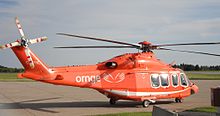 Ornge - Ontario's Air ambulance service helicopter
Ornge - Ontario's Air ambulance service helicopter
In some cases, air ambulance services will be provided by government, either directly or by means of a negotiated contract with a commercial service provider, such as an aircraft charter company. Such services may focus on the transfer of critical care patients, may support ground-based EMS on scenes, or may perform a combination of these roles. In almost all cases, the government will provide guidelines for use to both hospitals and EMS systems, in order to keep operating costs under control, and may specify operating procedures in some level of detail in order to limit potential liability, but almost always takes a 'hands-off' approach to the actual running of the system, relying instead on local managers with subject matter (physicians and aviation executives) expertise. Ontario's ORNGE program and the Polish LPR are examples of this type of operating system.[15] The Polish LPR is a national system covering the entire country and funded by the government through the Ministry of Health but run independently, there is no independent HEMS operator in Poland. In North East Ohio, including Cleveland, the Cuyahoga County-owned MetroHealth Medical Center uses its Metro Life Flight to transport patients to Metro's level I trauma and burn unit. There are 5 helicopters for North East Ohio and, in addition, Metro Life Flight has one fixed-wing aircraft.[17]
In the United Kingdom, the Scottish Ambulance Service operates two helicopters and two fixed-wing aircraft twenty-four hours per day. These represent the UK's only government-funded air ambulance service.
Multiple purpose
In some jurisdictions, cost is a major consideration, and the presence of dedicated air ambulances is simply not practical. In these cases, the aircraft may be operated by another government or quasi-government agency and made available to EMS for air ambulance service when required. In southern Queensland, Australia, the helicopter that responds as an air ambulance is actually operated by the local hydroelectric utility, with the Queensland Ambulance Service or New South Wales Ambulance Service providing paramedics, as required. In some cases, the flight paramedic will be provided to the aircraft operator by local EMS on an as-needed basis. In other cases, the paramedic will staff the aircraft full time, but will have a dual function. In the case of the Maryland State Police, for example, the flight paramedic is a serving State Trooper whose job is to act as the Observer Officer on a police helicopter when not required for medical emergencies.[18]
Fee-for-service
In many cases, local jurisdictions do not charge for air ambulance service, particularly for emergency calls. This is not, however, universally true. The cost of providing air ambulance services is considerable, and many such services, including government-run ones, charge for service. There are certain groups which, in particular, charge for service. These tend to be privately owned companies, such as aircraft charter companies, hospitals, and some private-for-profit EMS systems. Within the European Union, almost all air ambulance service is on a fee-for-service basis, except for those systems which operate by private subscription. Many jurisdictions have a mix of operation types. Fee-for-service operators are generally responsible for their own organization, but may have to meet government licensing requirements. Rega of Switzerland is an example of such a service.[19]
Donated by business
In some cases, a local business or even a multi-national company may choose to fund local air ambulance service as a goodwill or public relations gesture. Examples of this are common in the European Union, where in London the Virgin Corporation funds the Helicopter Emergency Medical Service, and in Germany and the Netherlands a large number of the 'Christoph' air ambulance operations are actually funded by ADAC, Germany's largest automobile club.[20] In Australia and New Zealand, many air ambulance helicopter operations are sponsored by the Westpac Bank. In these cases, the operation may vary, but is the result of a carefully negotiated agreement between government, EMS, hospitals, and the donor. In most cases, while the sponsor receives advertising exposure in exchange for funding, they take a 'hands off' approach to daily operations, relying instead on subject matter specialists.
Public donations
In some cases, air ambulance services may be provided by means of voluntary charitable fundraising, as opposed to government funding, or they may receive limited government subsidy to supplement local donations. Some countries, such as the U.K., use a mix of such systems. In Scotland, the parliament has voted to fund air ambulance service directly, through the Scottish Ambulance Service In England and Wales, however, the service is funded on a charitable basis via a number of local charities for each region covered, although the service to London receives most of its funding through the National Health Service.
Great strides were made in the UK between 2005 - 2008 when the independent charities formed themselves into the national association of air ambulance charities (AAAC) This organization is widely credited for having created the political climate which resulted in the helicopter industry and National Health Service recognising the enormous contribution that charities made to trauma care in the United Kingdom. In 2008, NHS partners joined the association and it was re-named the Association of Air Ambulances.
In recent years, the service has moved towards the physician-paramedic model of care. This has necessitated some charities buying expensive clinical governance services from independent "for profit" companies. The industry is currently divided over whether it is ethically acceptable that income derived through philanthropy and altruism should be spent on buying this essential governance from profit-driven entrepreneurs. Research has been commissioned (March 2010) and it is expected that in future, clinical governance will be provided either free or on a not-for-profit basis.
"Heavy-lift"
A final area of distinction which requires mention is the operation of truly large aircraft, generally fixed-wing in nature, as air ambulances. In the past the infrequency of demand for such a service in the civilian sphere meant that the majority of such operations are confined to the military, which requires them in support of overseas combat operations. Military organizations with a capability of this type of specialized operation include the United States Air Force,[21] the German Luftwaffe, and the British Royal Air Force. Each operates aircraft staffed by physicians, nurses, and corpsmen/technicians, and each has the capability of providing long distance transport, along with all required medical support, to dozens of injured persons simultaneously.
However, in recent years exceptions to the "military-only" rule have grown with the need to quickly transport injured persons to facilities providing higher levels of care or to repatriate individuals. ADAC, the German automobile club, and Mercy Jets,[22] use both large and small fixed wing aircraft configured to provide levels of care that can be found in Trauma centers for individuals who subscribe to their own health insurance or affiliated travel insurance and protection plans.
- Heavy lift capability
Standards
Aircraft and flight crews
In most jurisdictions, air ambulance pilots must have a great deal of experience in piloting their aircraft because the conditions of air ambulance flights are often more challenging than regular non-emergency flight services. After a spike in air ambulance crashes in the United States in the 1990s, the U.S. government and the Commission on Air Medical Transportation Systems (CAMTS) stepped up the accreditation and air ambulance flight requirements, ensuring that all pilots, personnel, and aircraft meet much higher standards than previously required.[23] The resulting CAMTS accreditation, which applies only in the United States, includes the requirement for an air ambulance company to own and operate its own aircraft. Some air ambulance companies, realizing it is virtually impossible to have the correct medicalized aircraft for every mission, instead charter aircraft based on the mission-specific requirements.
While in principle CAMTS accreditation is voluntary, a number of government jurisdictions require companies providing medical transportation services to have CAMTS accreditation in order to be licensed to operate. This is an increasing trend as state health services agencies address the issues surrounding the safety of emergency medical services flights.[23] Some examples are the states of Colorado,[24] New Jersey,[25] New Mexico,[26] Utah,[27] and Washington.[28] According to the rationale used to justify the state of Washington's adoption of the accreditation requirements, requiring accreditation of air ambulance services provides assurance that the service meets national public safety standards. The accreditation is done by professionals who are qualified to determine air ambulance safety. In addition, compliance with accreditation standards is checked on a continual basis by the accrediting organization. Accreditation standards are periodically revised to reflect the dynamic, changing environment of medical transport, with considerable input from all disciplines of the medical profession.
Other U.S. states require either CAMTS accreditation or a demonstrated equivalent, such as Rhode Island,[29] and Texas, which has adopted CAMTS' Accreditation Standards (Sixth Edition, October 2004) as its own. In Texas, an operator not wishing to become CAMTS accredited must submit to an equivalent survey by state auditors who are CAMTS-trained.[30][31] Virginia and Oklahoma have also adopted CAMTS accreditation standards as their state licensing standards.[23] While the original intent of CAMTS was to provide an American standard, air ambulance services in a number of other countries, including three in Canada and one in South Africa, have voluntarily submitted themselves to CAMTS accreditation.
Medical staffing
The makeup of the medical crew staffing an air ambulance varies depending on country, area, service provider, and type of air ambulance. In services operating under the Anglo-American model of service delivery, the helicopter is most likely to be used to transport patients, and the crew may consist of Emergency Medical Technicians, Paramedics, flight nurses, a Respiratory Therapist, or in some cases, a physician. Services with a primary focus on critical care transport are more likely to be staffed by physicians and nurses. In the Franco-German model, the aircraft is much more likely to be used as a method of delivering high level support to ground-based EMS. In these cases, the crew generally consists of a physician, often a surgeon, anesthetist, trauma specialist or similar specialty, accompanied by a specially trained advance care paramedic or nurse. In these cases, the object is the rapid delivery of definitive care, occasionally even performing emergency surgical procedures in the field, with the eventual transport of the patient being accomplished by ground ambulance, not the helicopter.
Medical control
The nature of the air operation will frequently determine the type of medical control required. In most cases, the available skill set for an air ambulance staffer is considerably greater than that of a typical paramedic. As a result, those operating in this environment will often be permitted by medical control to exercise more latitude in medical decision-making. Assessment skills tend to be considerably higher, and, particularly on interfacility transfers, permit the inclusion of such factors as the reading of x-rays and the interpretation of lab results. This allows for planning, consultation with supervising physicians, and the issuing of contingency orders in case they are required during the flight. Some systems operate almost entirely off-line, using protocols for almost all procedures and only resorting to on-line medical control when protocols have been exhausted. Some air ambulance operations have full time, on site medical directors with pertinent backgrounds (e.g., emergency medicine); others have medical directors who are only available by pager.[32] For those systems operating on the Franco-German model, the physician is almost always physically present, and medical control is not an issue.
Equipment and interiors
Most aircraft used as air ambulances, with the exception of charter aircraft and some military aircraft, are equipped for advanced life support and have interiors that reflect this. The challenges in most air ambulance operations, particularly those involving helicopters, are the high ambient noise levels and limited amounts of working space, both of which create significant issues for the provision of ongoing care. While equipment tends to be high-level and very conveniently grouped, it may not be possible perform some assessment procedures, such as chest auscultation, while in flight. In some types of aircraft, the aircraft's design means that the entire patient will not be physically accessible in flight. Additional issues occur with respect to pressurization of the aircraft. Not all aircraft used as air ambulances in all jurisdictions have pressurized cabins, and those which do typically tend to be pressurized to only 10,000 feet above sea level. These pressure changes require advanced knowledge by flight staff with respect to the specifics of aviation medicine, including changes in physiology and the behaviour of gases.
There are a large variety of helicopter makes that are used for the civilian HEMS models. The commonly used types are the Bell 207, 407, and 429, Eurocopter AS-350, BK-117, EC130, EC135, EC145, and the Agusta Westland 109 & 149. Due to the configuration of the medical crew and patient compartments, these aircraft are normally configured to only transport one patient but some can be configured to transport two patients if so needed. Additionally, helicopters have stricter weather minimums that they can operate in and commonly do not fly at altitudes over 10,000 feet above sea level.
- Equipment and interiors
Challenges
Beginning in the 1990s, the number of air ambulance crashes in the United States, mostly involving helicopters, began to climb. By 2005, this number had reached a record high. Crash rates from 2000–2005 more than doubled the previous five year's rates.[33] To some extent, these numbers had been deemed acceptable, as it was understood that the very nature of air ambulance operations meant that, because a life was at stake, air ambulances would often operate on the very edge of their safety envelopes, going on missions in conditions where no other civilian pilot would fly. As a result, nearly fifty percent of all EMS personnel deaths in the United States occur in air ambulance crashes. In 2006, the United States National Transportation Safety Board (NTSB) concluded that many air ambulances crashes were avoidable,[34] eventually leading to the improvement of government standards and CAMTS accreditation.[35]
Cost-effectiveness
Whilst some air ambulances do have effective methods of funding, in the UK, they remain almost entirely charity funded, as improved cost-benefit ratios are generally achieved with land based attendance and transfers. Health outcomes, for example from London's Helicopter Emergency Medical Service, remain largely the same for both air and ground based services.[36]
See also
- MEDEVAC
- Medical escort
- Golden hour (medicine)
- Emergency medical service
- Emergency Medical Retrieval Service
- Air Ambulances in the United Kingdom
- Air Ambulances in the United States
- Norwegian Air Ambulance Foundation
- Safety of emergency medical services flights
- Commission on Accreditation of Medical Transport Systems
References
- ^ Lam DM. "To Pop A Balloon: Air Evacuation During The Siege of Paris, 1870." Aviation, Space, & Environmental Medicine, 59(10): 988-991, October 1988.
- ^ "Help From The Skies." Popular Mechanics, November 1929.
- ^ "Lam, DM. Wings of Life and Hope: A History of Aeromedical Evacuation." Problems in Critical Care, 4(4): 477-494, December 1990.
- ^ Flight, 13 April 1956 p424.
- ^ "Accidental Death and Disability: The Neglected Disease of Modern Society." National Academy of Sciences (White Paper), 1966.
- ^ Bearl, Spc. Daniel. "MEDEVAC Unit Stays on Alert to Save Injured Comrades." US Military News via army.mil/-news, February 9, 2007. Retrieved: December 4, 2010.
- ^ "Royal Flying Doctor Service." flyingdoctor.net. Retrieved: December 4, 2010.
- ^ Naughton, Russell. "Marie Marvingt "La Fiancée du Danger" (1875-1963)." monash.edu.au, 2010. Retrieved: December 4, 2010.
- ^ "Saskatchewan Air Ambulance." Government of Saskatchewan. Retrieved: December 4, 2010.
- ^ "Schaefer Ambulance Service." schaeferamb.com. Retrieved: December 4, 2010.
- ^ "The History of the Air Ambulance" Retrieved: November 15, 2011.
- ^ "Our History: Forest General Hospital." forrestgeneral.com. Retrieved: December 4, 2010.
- ^ "Cristoph1" (in German). christoph-1.de. Retrieved: December 4, 2010.
- ^ "First in the Nation - Celebrating 37 Years of Air Medical Transport!" Flight for Life, 2006. Retrieved: December 4, 2010.
- ^ a b "History." ornge.ca. Retrieved: December 4, 2010.
- ^ "Air Ambulances: Fixed-Wing v. Rotor-Wing" MedFlight911.com Retrieved: November 15, 2011.
- ^ "Metro Life Flight." The MetroHealth System. Retrieved: December 4, 2010.
- ^ "Governor O'Malley Announces New Additions to Maryland's World-Class Emergency Response." Maryland State Police Aviation Command via mspaviation.org, October 20, 2010. Retrieved: December 4, 2010.
- ^ "Rega Switzerland." rega.ch/en. Retrieved: December 4, 2010.
- ^ "ADAC." adac.de. Retrieved: December 4, 2010.
- ^ "USAF 357: Medical Airlift Group." public.scott.amc.af.mil. Retrieved: December 4, 2010.
- ^ "Air Ambulance." mercyjets.com. Retrieved August 26, 2011.
- ^ a b c Davis, Robert. "Reconsidering air ambulance usage" USA Today, July 18, 2005. Retrieved: November 12, 2007.
- ^ "Colorado House Bill 07-1259." State of Colorado. Retrieved: December 4, 2010.
- ^ "State of New Jersey Assembly Act No. 3786." State of New Jersey. Retrieved: December 4, 2010.
- ^ "Emergency Air Ambulance Services." New Mexico Register, Volume XVI, Number 24, December 30, 2005.
- ^ "Utah Rule R426-2." State of Utah. Retrieved: December 4, 2010.
- ^ Washington State rule WAC 246-976-320." Washington: DC. Retrieved: December 4, 2010.
- ^ "Rules and Regulations Relating to Emergency Medical Services." Rhode Island Department of Health. Retrieved: December 4, 2010.
- ^ "Draft of proposed changes to Texas Department of State Health Services rule 157.12." dshs.state.tx.us. January 25, 2006."] State of Texas. Retrieved: December 4, 2010.
- ^ "Texas DSHS committee minutes
- ^ "Department of Community Health Policies and Procedures." EMS. Retrieved: December 4, 2010.
- ^ Levin, Alan and Robert Davis. "Surge in crashes scars air ambulance industry." USA Today, July 17, 2005. Retrieved: November 12, 2007.
- ^ "Official NTSB report on an air ambulance Learjet crash in San Diego, California which killed everyone on board, amounting to five deaths." NTSB Publication, October 24, 2004. Retrieved: November 12, 2007.
- ^ Levin, Alan. "NTSB: Air ambulance crashes avoidable." USA Today, January 25, 2006. Retrieved: November 12, 2007.
- ^ Brazier, J. "The cost and effectiveness of the London Helicopter Emergency Medical Service." J Health Serv Res Policy, 01-OCT-1996; 1(4): 232-7.
External links
- Association of Air Medical Services
- UK Air Ambulance Information & Operational Info + Gallery
- U.S. State Department information on U.S. based air ambulance and medevac companies
- "Lifeguard" flight tracker
- HEMS Pictures by State
Emergency medical services People Emergency medical dispatcher (EMD) · Certified first responder (CFR) · Emergency medical responder (EMR) · Emergency medical technician (EMT) · Paramedic · Medical director · Combat medicVehicles Air ambulance · Ambulance (history) · Ambulance bus · Boat ambulance · Combination car · Ambulance emergency response vehicle · Light horse field ambulance · Motorcycle ambulance · Dodge WC54Casualty lifting
and movementOther Related fields Categories:- Air ambulance services
Wikimedia Foundation. 2010.

